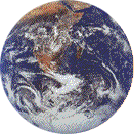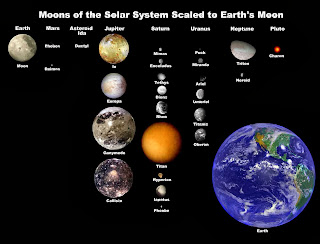The known Universe contains ~200 billion galaxies and is ~13.72 billion years old.
The Milky Way Galaxy contains ~200 billion stars and is ~13.2 billion years old.
So, there could be a galaxy in the universe for every star in the Milky Way Galaxy.
Planet Earth is 4.54 billion years old (the moon is 4.527 billion years old).
One million Earths could fit inside the Sun.
The Milky Way Galaxy is 100 billion times larger than the Sun.
The average distance between stars is 20 million million miles.
www.universetoday.com
http://curious.astro.cornell.edu
~4.3 billion years ago: First rocks formed
~4 billion years ago: Atmosphere and ocean formed.
~3.9 billion years ago: End of Late Heavy Bombardment (asteroids and comets)
~3.85 billion years ago: Origin of life: First prokaryotes (simple cells, no nucleus)
~3.5 billion years ago: Photosynthesis began in cyanobacteria
~2.4 billion years ago: Great Oxygenation Event (GOE)
~2 billion years ago: First eukaryotes (complex cells)
~1 billion years ago: First multicellular organisms such as red algae
~900 million years ago: A day on Earth was 18 hours and a years was 481 days.
~600 million years ago: First fungi, jellyfish, sponges, worms (first primitive brain & eyes)
~570 million years ago: First arthropods (ancestors of insects, arachnids and crustaceans)
~543 million years ago: Cambrian explosion (Complex animal life starts).
~500 million years ago: First fish (chordates)
~470 million years ago: First land plants
~420 million years ago: First jawed fish
~400 million years ago: First insects
~385 million years ago: First seeds
~380 million years ago: First tetrapods (four feet)
~375 million years ago: First forests
~360 million years ago: First amphibians
~320 million years ago: First reptiles
~300-180 million years ago: Pangea (super continent) existed.
~251 million years ago: Permian Extinction
~240-65 million years ago: Dinosaurs existed
~220 million years ago: First mammals
~140 million years ago: First birds (feathers before flight)
~135 million years ago: First flowers
~130 million years ago: First marsupial mammals
~100 million years ago: First eutherian (placental) mammals
~65 million years ago: First primate-like mammals, or proto-primates
~60 million years ago: First grasses
~35 million years ago: First monkeys
~14 million years ago: First apes
~6 million years ago: Hominids branch off from other primates
~4.5 million years ago: Australopithecines (early bipedal hominids)
~2.3 million years ago: First humans (Homo habilis)
~250,000-30,000 years ago: Neanderthals existed.
~150,000 years ago: Anatomically modern people (Homo sapiens)
~35,000 years ago: Symbolic art for first time
~11,300-5,500 years ago: Stone Age (Neolithic)
~10,000 years ago: End of last Ice Age and start of First Agricultural Revolution
~6,000 years ago: First cities (Damascus is one of the oldest continuously inhabited).
~5,500-3,400 years ago: Bronze Age
~5,000 years ago: First written languages: Mesopotamian cuneiform and Egyptian hieroglyphs
~3,400-1,600 years ago: Iron Age
~3,450 years ago: First written Greek
~3,200 years ago: First written Chinese
2,400-1,537 years ago: Roman Empire existed (not counting Eastern Empire)
~1,550-650: Dark Ages (Middle Ages) Ends when the Renaissance starts.
714-90 years ago: Ottoman Empire existed.
~180 years ago: Industrial Revolution started.
great chart
Formation of atmosphere and ocean
The oxygen released due to photosynthesis is
because of water, not carbon dioxide.
great timeline
http://youtu.be/21zgkg5pCaE Origin of Life with David Attenborough
First Life, BBC
http://youtu.be/Xsn3wpVAcjk National Geographic: The Story of Earth HD
http://youtu.be/NWKijOdOloc History of the World - History Channel Documentary
Types of Galaxies
Hubble discovered that the universe is "expanding" and that
there exists billions of galaxies, all moving very quickly.
Most abundant elements in the Sun
Elements in Earth's air
Elements in Earth's crust
Elements in the human body
There are more atoms in a human body
than there are stars in the universe.
It takes 225 million years for our Sun to travel round the galaxy.
It takes 8 minutes for sunlight to reach the Earth.
It take one year (365 days) for Earth to revolve around the sun.
Earth moves at ~66,000 miles per hour.
The path of the revolution is an ellipse, not a circle.
It rotates every 24 hours (spins on axis 1,000+ miles per hour)
It is because of the 23.5% tilt of the Earth's axis that there are seasons
In the Northern Hemisphere, Earth is closer to the sun in the winter,
furthest in summer. The average distance from the Earth to
the Sun is 93 million miles.
Hubble telescope
Telescopes are like time machines.
With the Hubble Telescope it is possible to see the universe
when it was only 800 million years old.
Since stars are so far away (many light years),
we see the stars how they used to look.
tiny planet Earth from Voyager I in 1990 from edge of Solar System
World population in 2013: 7.2 billion
People that have lived on Earth: ~106 billion
There exist about 8 million species in 2013.
It is estimated that there have been 4 billion
species that have existed on Earth.
In regard to language, there are about 6,700 languages in 2013.
It is estimated that there have been as many as 100,000 languages.
---------------------------------------------------------
Of the 8 million (could be many more) species alive today, only
5,400 are mammal species, and only 435 of those are primates.
There are 75,000 living species of chordates.
64,000 species are vertebrates.
(Only 3% of animals are vertebrates)
The average life-span of a species is 4 million years.
Language Tree
Pangea (Pangaea) with modern-day countries labeled
North America was completely separated from Pangea
about 130 million years ago. The South American plate
was separated by 80 million years ago. By 3 million years
ago, North and South America had once again connected.
http://youtu.be/NYbTNFN3NBo Earth during the past 650 million years and future
http://youtu.be/cQVoSyVu9rk Earth during the past 600 million years
The Earth and the continents (plates) after 250 million years
are predicted to one super continent once again. Names I have
seen for this are Pangea Amasia, Pangea Proxima and Pangea Ultima.
| VENUS | EARTH | MARS | |
| SURFACE PRESSURE | 100,000 mb | 1,000 mb | 6 mb |
| COMPOSITION | |||
| CO2 | >98% | 0.03% | 96% |
| N2 | 1% | 78% | 2.5% |
| Ar | 1% | 1% | 1.5% |
| O2 | 0.0% | 21% | 2.5% |
| H2O | 0.0% | 0.1% | 0-0.1% |
 Venus |  Earth |  Mars | |
There are species that only exist on Madagascar and India.
From Soup to Cells—the Origin of Life
 | |
| A microbe-like cellular filament found in 3.465 billion year old rock | |
When did life originate?
Evidence suggests that life first evolved around 3.5 billion years ago. This evidence takes the form of microfossils (fossils too small to be seen without the aid of a microscope) and ancient rock structures in South Africa and Australia called stromatolites. Stromatolites are produced by microbes (mainly photosynthesizing cyanobacteria) that form thin microbial films which trap mud; over time, layers of these mud/microbe mats can build up into a layered rock structure — the stromatolite. Stromatolites are still produced by microbes today. These modern stromatolites are remarkably similar to the ancient stromatolites which provide evidence of some of the earliest life on Earth. Modern and ancient stromatolites have similar shapes and, when seen in cross section, both show the same fine layering produced by thin bacterial sheets. Microfossils of ancient cyanobacteria can sometimes be identified within these layers.
 |  | |
| Modern stromatolites in Shark Bay, Australia | ||
 |  | |
| Cross sections of 1.8 billion year old fossil stromatolites at Great Slave Lake, Canada | ||
 | |
| A hydrothermal vent at the bottom of the ocean | |
Scientists are exploring several possible locations for the origin of life, including tide pools and hot springs. However, recently some scientists have narrowed in on the hypothesis that life originated near a deep sea hydrothermal vent. The chemicals found in these vents and the energy they provide could have fueled many of the chemical reactions necessary for the evolution of life. Furthermore, using the DNA sequences of modern organisms, biologists have tentatively traced the most recent common ancestor of all life to an aquatic microorganism that lived in extremely high temperatures — a likely candidate for a hydrothermal vent inhabitant! Although several lines of evidence are consistent with the hypothesis that life began near deep sea vents, it is far from certain: the investigation continues and may eventually point towards a different site for the origin of life.
What happens to the helium formed in the sun?
All the helium in the universe has been created by the fusion of hydrogen atoms, either in the early universe or in stars.
What happens to the Helium? Most stars, after converting a significant portion of their hydrogen to helium undergo an internal change. The internal core collapses, and heats up, until it is hot enough to fuse helium into larger atoms, for instance, by combining three helium atoms into carbon. At this same time, some helium will fuse with that carbon to produce oxygen. Outside the core, in what's called the envelope, there is still enough hydrogen to fuse into more helium. But the core begins fusing into larger atoms. This, by the way, is the transition from a 'normal' star like our sun to a Red Giant.
It's basically a free-for-all for creating larger and larger atoms. As soon as the helium in the core runs out, the star collapses again, heats up, and starts fusing carbon and oxygen into larger atoms. If the star is massive enough, this keeps happening until iron is fused. At which point a hotter core still won't lead to fusion. The star collapses, becomes unstable, and POW. Explodes, forming a supernovae and neutron star.
http://curious.astro.cornell.edu
"The main lesson of Biogeography is that only evolution can explain the
diversity of life on continents and islands. But there is another lesson as well:
the distribution of life on earth reflects a blend of chance and lawfulness.
Chance, because the dispersal of animals and plants depends on unpredictable
vagaries such as winds, currents, and the opportunity to colonize....
But there is also lawfulness. Evolutionary theory predicts that many animals
and plants arriving in new and unoccupied habitats will evolve to thrive there,
and will form new species, filling up ecological niches. And they will usually
find their relatives on the nearest island or mainland. This is what we see, over
and over again. One cannot understand evolution without grasping its unique
interaction between chance and lawfulness-an interaction that...is critically
important is understanding the idea of natural selection."
Jerry Coyne









































































































Lots of Good information in your post, I favorited your blog post so I can visit again in the future, Thanks.
ReplyDeleteflat earth map